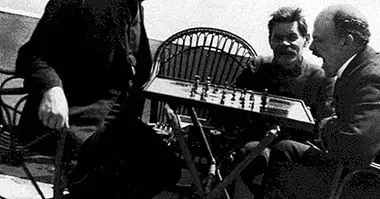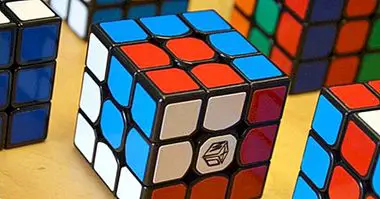8 cognitive stimulation exercises for seniors
As with our ability or physical performance, over the years, our psychological skills decline due to age-specific neurological degeneration. If we add to this the possibility of suffering from a neurodegenerative disease, these functions are still more affected.
With the intention of delaying or delaying this cognitive deterioration over time, experts in the field of neurology have devised a series of cognitive stimulation exercises , which can help people maintain or improve their mental abilities.
- Related article: "The 4 psychological changes in old age (memory, attention, intelligence, creativity)"
What is cognitive stimulation?
Cognitive stimulation exercises consist of a whole series of tasks or activities that have been designed with the aim of protecting, maintaining or even improving cognitive functions, since these tend to get worse over the years.
For this, the mental health expert can design a structured program of stimulation that is adapted to the needs of the person and through activities that exercise functions such as memory, attention, perception, concentration, language production and functions. executives, this can enhance or maintain their cognitive functions "in shape", as well as slow down the cognitive deterioration produced by age or by some type of neurodegenerative disease .
Over the years, our body changes and degenerates. This degeneration that takes place very slowly and progressively affects both our physical and psychological capacities and intensifies with the appearance of any form of neurodegenerative disease.
In neurodegenerative diseases, such as Alzheimer's dementias, amyotrophic lateral sclerosis (ALS), Huntington's and Parkinson's diseases or Friedreich's ataxias, they cause the progressive death of neural tissue, which entails disastrous consequences for both the physical health of the person, and the cognitive functioning of this .
In these specific cases, although cognitive stimulation exercises can not stop the progression of the disease, to some extent they can slow it down, and also facilitate the person to lead a life as dependent as possible.
In order to carry out this cognitive stimulation in an effective way, the functions that the person still has must be encouraged or enhanced, since if we try to recover a function that has disappeared completely, the only thing we can achieve is to increase the levels of frustration of the person. patient.
If we otherwise exercise the functions that are still active, in addition to regenerating or making the functioning of these abilities prosper, The self-esteem of the patient and the feeling of self-efficacy will also be improved , which will be reflected as an improvement in the quality of life of the patient.
With the intention of creating a program that is most adapted to the specific needs of the person, before starting the treatment, the professional must carry out an assessment of the patient's cognitive abilities state, then establish objectives and design an adequate program to achieve these.
In what cases can you practice?
The design of exercise programs for cognitive stimulation are designed to intervene and act on the demands or usual needs that usually appear over the years or with the onset of a neurodegenerative disease.
The most common cases that require this type of activities include:
- Prevention of cognitive degeneration .
- Alterations of memory, losses and forgetfulness.
- Slow the development of dementias in mild or initial phases.
- Problems in executive functions .
- Prevention of falls, improvement of motor coordination and praxies.
- Alteration of spatio-temporal orientation.
- Maintenance of language skills and communication.
- Favor mental lucidity and the reasoning.
- Maintenance of visuoperceptive, visuospatial and visuoconstructive functions.
- Cognitive symptomatology of depressive disorders.
- Cognitive stimulation exercises.
There are many games, tasks or activities that can serve as cognitive stimulation exercises . Although some of them are traditional games, commonly associated with the training of agility or mental abilities, many others have been specially created for this purpose.
Among some of these activities we find:
1. Reading and writing exercises
The simple fact of maintaining reading habits, as well as writing in a diary or transcribing some texts, can help protect and enhance creativity and attention , as well as working memory processes.
2. Traditional board games
Some traditional board games like the parchís, the cards or the domino besides favoring the social interactions, have a lot of benefits when it comes to training cognitive skills .
Some of the functions or skills exercised are attention and concentration, working memory and short-term memory or critical thinking and flexibility of thought, since it is necessary to change the strategies as the game progresses.
3. Drawing and painting
In addition to being an extremely relaxing activity, drawing and painting exercises exercise creativity and concentration and, in addition, are very motivating for the person.
4. Crosswords, sudoku and word searches
The main advantage of this type of activities is that they are practically endless, this means that the person can increase the level of difficulty of the exercises and thus develop more and more aspects such as perception, memory processes, logic and deductive analysis, planning strategies, working memory, coordination and patience.
5. Tangram
The tangram is a traditional game of Chinese origin in which by reordering geometric pieces, the person must get to conform a series of pre-established forms.
Thanks to this original game, the person can exercise skills such as visoperceptive capacity, visuospatial orientation, attention and concentration , the capacity for abstraction, cognitive flexibility, creativity and motor skills.
6. Exercise: How many are there?
In this game, the patient a series of geometric figures are presented , composed of other figures of the same characteristics. Next you are asked to count how many geometric figures there are in total.
With this activity it is possible to enhance the attention and concentration, the visoperceptive capacity, the planning or the perseverance.
7. Exercise: "The word search"
In this activity the person who creates new words is asked from a list of words already given. Thanks to her we can exercise the Attention capacity, ability to plan and reading skills or associated with the lexicon and the vocabulary.
8. Exercise: "Grill of a hundred"
In general, all mathematical activities can be useful for exercising cognitive functions. In the "Parrilla de cien" exercise, the person is presented with a grid with numbers from one to a hundred and is asked to perform a series of operations with them.
Through this and other mathematical exercises are exercised attention and concentration skills, visoperceptive ability, calculation and cognitive flexibility.



















